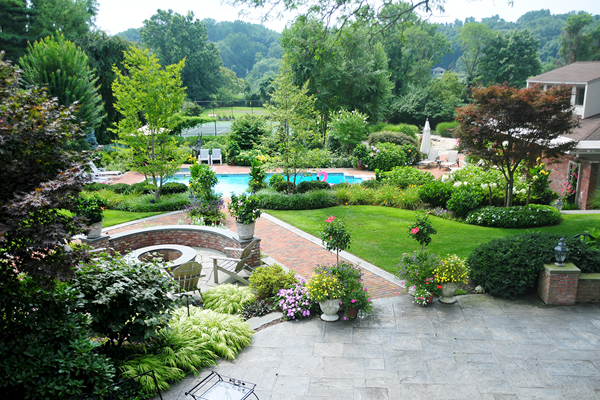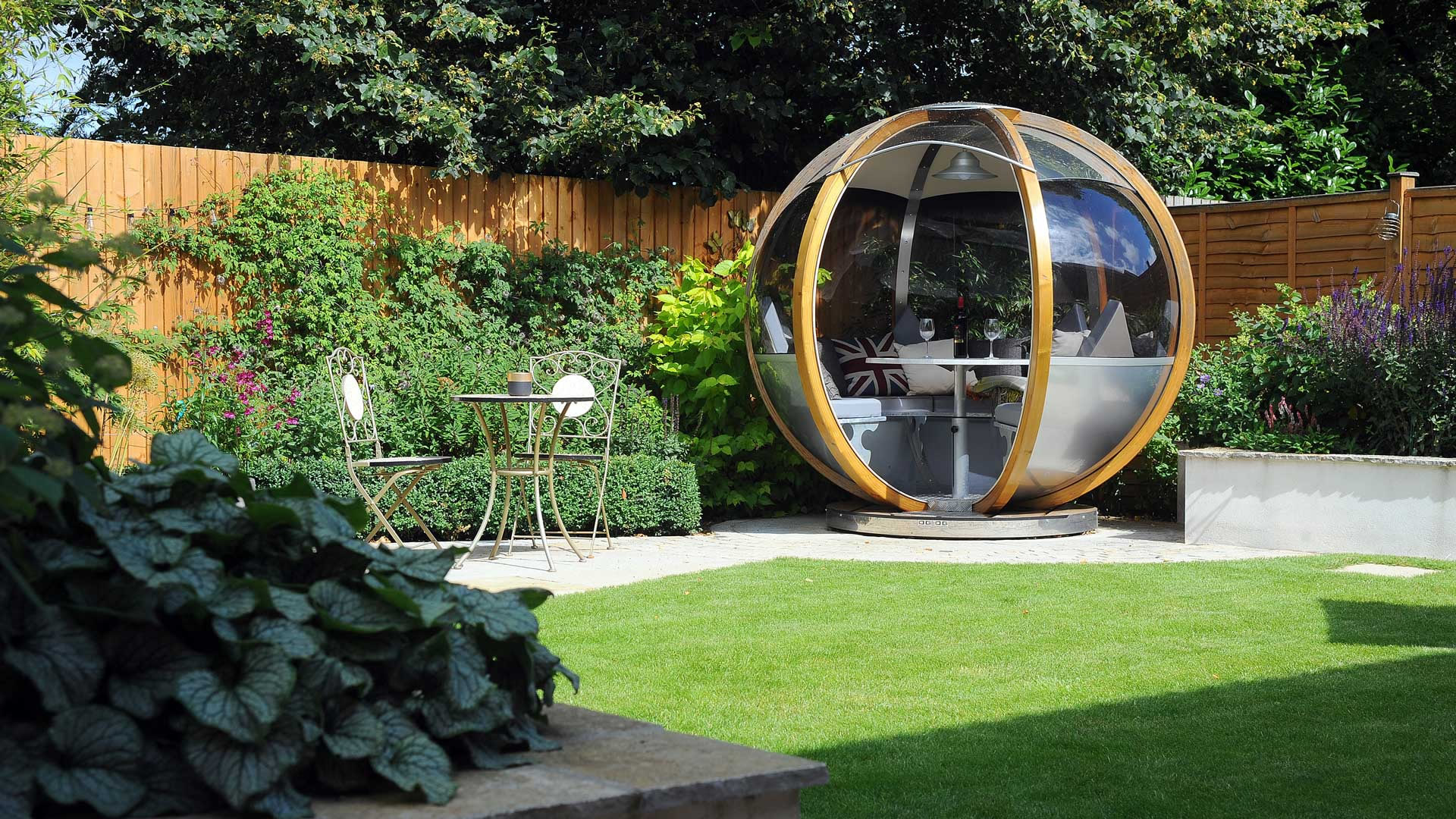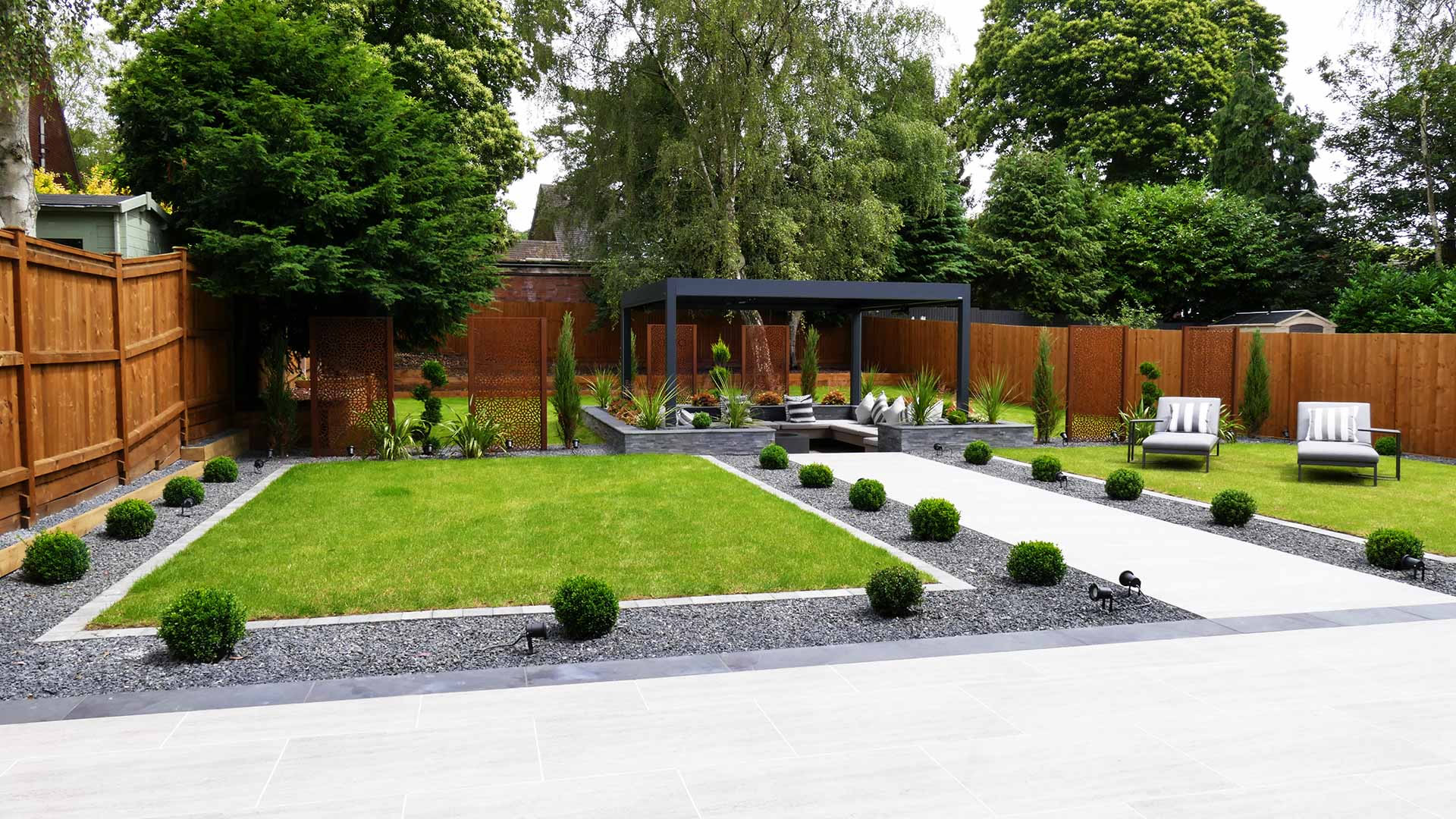Landscape gardening is more than just arranging plants and flowers; it is an art and practice of combining functionality and visual appeal. This helps create a melodious outdoor space in your garden, park, yard, and other green areas. It primarily involves careful planning and design based on multiple factors, including climate, soil conditions, and the visual style you want to add to your outdoor space.
Landscape gardening beautifies any space and offers eco-friendly benefits, including air purification, erosion control, and biodiversity. It includes multiple components, such as the selection of plants, layout of paths and patios, weather feature installation, and use of decorative stones or wood. This guide helps you understand the fundamentals of landscape gardening, which will help you make an informed decision about creating a harmonious space that shows your character while cultivating the natural ecosystem.
Understanding Hardscape, Softscape & Waterscape
Hardscape
Hardscape is one of the best subcategories of landscaping. It involves non-living elements in landscaping, such as a wooden arbour, a stone wall, or a brick patio. You can utilise hardscape elements at multiple locations, such as:
Typically, hardscapes are eco-friendly so that you can benefit from the natural environment in your space. Hardscape elements like retaining walls are used to manage soil and create lawn edges with pavers. Hardscaping also helps control water runoff, reducing reliance on artificial drainage by installing pathways, driveways, or patios.
Softscape
Every landowner considers softscape in their yards. It is the gardening section of any landscape design, and it includes lively things such as shrubs, flowers, succulents, and trees. You can add:
- Decorative grasses
- Fruit or decorative trees
- Ground cover like clover or mulch
- Flowers
Waterscape
Waterscape is the art of adding water features such as a bubbling brook, dancing fountains, or a calm pond to your landscape, turning your outdoor area into a peaceful oasis. The aim is to harmoniously balance the natural environment and the supplementary water elements. Waterscapes can be added to:
- Parks
- Public squares
- Gardens
- Riverfronts
You can combine hardscape, softscape, and waterscape to create a balanced and visually appealing outdoor environment. This combination enhances aesthetics, functionality, and sustainability in landscape design.

What Are the 5 Key Elements of Landscape Design?
A visually appealing landscape design includes five fundamental elements: line, form, texture, colour, and scale. By balancing these design elements, you can make a space more visually appealing and harmonious.
Line
Lines help direct movement in landscaping, such as on walkways and paths, and create the illusion of distance and depth. It can highlight features like ponds, pools, or fire pits. Created from hardscape materials (pavers, natural stone) or vegetation, they enhance visual appeal by taking multiple straight, horizontal, curved, or diagonal shapes. Straight lines produce a more formal design, but curved lines suit an informal landscape.
Form
The form indicates plant shape or hardscape features, which can be free-form, round, upright, or groundcover. Hardscape elements like stone paths, retaining walls, and pergolas come in different heights and shapes. A good landscape design pays close attention to these forms.
For instance, a formal garden may have neatly trimmed shrubs, while an informal yard would have more natural, flowing plants. Mixing different forms can enhance the overall design.
Colour
Colour is the first thing people notice when they enter a landscape. This is a crucial aspect of landscape design because it draws attention. When planning a garden, you should consider all four seasons. While vibrant flowers and plants are magnificent in summer, plants that provide colour in other seasons are essential. These include evergreens, conifers, and holly, ensuring your landscape remains visually appealing all year round.
In addition to plant life, the material you choose for hardscaping also significantly affects the overall design. Do you prefer a bright focal point, like a blue pool, or something more understated, such as natural stepping stones? The selection of materials can greatly affect your garden's mood, from lively and colourful to serene and natural.
Texture
Texture is an essential element in both softscapes and hardscapes. It refers to the characteristics of a design feature or plant, whether hard or soft, fine or coarse, heavy or light and rough or smooth.
Texture adds interest to a space and helps show its size and shape. By combining soft leaves, rough stones, and various pavements, pathways can be transformed into sensory experiences. Seasonal variations in plant textures, such as spring flowers and autumn bark, keep designs vibrant throughout the year. Using texture appropriately will also enhance spaces and draw people to their surroundings.
Scale
Using different heights and widths can improve your design. Make sure your hardscape and softscape elements match the dimensions of your home and yard. This will create visual interest and a balanced outdoor space. Pay attention to the size of your plants, pathways, and structures to ensure they complement the surroundings. By carefully combining different sizes, you can create a dynamic and pleasing landscape.
What Are the Key Aspects of Landscape Gardening?
Considering factors such as weather conditions, soil conditions, and local ecology, landscaping provides a balanced and aesthetically pleasing outside space that matches the needs of the space and the house owner or landlord. There are multiple aspects of landscape gardening:
Site Analysis: Understanding the climate, soil, drainage, and existing vegetation.
Plant Selection: Choosing plants that suit the climate, soil, and sunlight conditions.
Design: Creating a plan for the space, including the layout, plant selection, and features like seating areas.
Texture: Incorporating a mix of textures, such as different types of plants, paving stones, and structures.
Hardscaping: Incorporating non-living elements like stone, wood, or concrete into the landscape.
Water Features: Adding sound, texture, and movement to the landscape with waterfalls, swimming pools, and other water features.
Water Management: Installing irrigation systems and drainage solutions to ensure plants get enough water and to control erosion and flooding.
Seating: Providing comfortable seating and dining areas.
Rhythm and Echoes: Creating a consistent repetition of materials and elements to create rhythm and movement.
Maintenance: Regularly checking plants for pests and diseases, mowing lawns, and trimming trees and hedges.

Benefits of Hiring a Professional Landscape Gardener?
Proper landscaping can help unify your garden or outdoor space. However, it can also be challenging, time-consuming, and costly if anything goes wrong. This is where an expert landscape gardener comes in. Here are multiple reasons why hiring one might be a good decision.
Expertise
Qualified landscapers have deep knowledge of plant choice, soil state, and design principles. They use specialised maintenance methods to ensure your garden is healthy and pleasing to the eyes.
Custom Design
They are more open to creating a custom landscape plan that suits your home's architecture, personal desires, and preferred aesthetics based on sunlight exposure and drainage.
Time-Saving
They help you save time and effort by handling all aspects of the landscaping job, including planting, pruning, weeding, and hardscaping.
Quality Materials and Equipment
Experts are equipped with multiple high-quality vegetation materials and specialised tools that are not usually available to homeowners or landlords.
Increased Property Value
A carefully maintained, skilfully landscaped yard can considerably improve your property's curb appeal and market value.
Attention to Detail
Well-trained landscapers deliver exceptional results with proper attention to detail to ensure all aspects of your landscape are completed to higher standards.
Project Management
They can handle the overall job, from design to completion, including managing timelines, permits, and potential challenges.
Contact Us to Transform Your Outdoor Dreams into Reality
If you are a landscaping enthusiast but hesitant about going for it, we have you covered. A and M Groundworks is your partner for a beautifully crafted outdoor space that enhances your property’s overall aesthetic appeal. Just give us a call and let us envision your landscaping dream.

